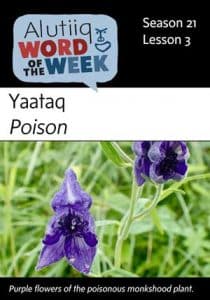 Yaataq—Poison
Yaataq—Poison
Pitun’illgu una-yaatartuq!—Don’t eat this—it is poisonous!
Alutiiq people have long recognized the poisonous qualities of certain local plants. Some of these plants were harvested for their medicinal value, and at least one was used in hunting. The most well-known Alutiiq poison was made from the roots of the monkshood plant, Aconitum delphinifolium. This beautiful blue-flowered herb grows in meadows and has a long slender stem. According to one historic source, the roots were dried, pounded or grated, mixed with water, and left to ferment. Fat from the corpse of a dead whaler was then added to the concoction to make a chemically and spiritually potent toxin.
Aconite poison contains an alkaloid that paralyzes the nervous system and lowers both body temperature and blood pressure. Whalers used it to immobilize whales. They smeared the poison on the long tips of slate whaling darts that they cast into the side or the tail of an animal. Although the poison did not kill the whale immediately, it acted over several days to paralyze the animal, which eventually drowned. With luck, the carcass would float to shore, providing abundant food and raw material for the whaler’s community.
Source: Alutiiq Museum
